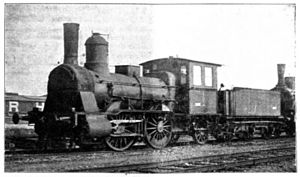Prussian G 2
In the genus G 2 which ordered Royal Prussian State Railways several older freight locomotives with the axis sequences a B1 and C, which she had inherited from their predecessors tracks. There were also some G 3 locomotives from the Frankfurt / M directorates. and Mainz. The best known was the normal design of the G 2.
Prussian G 2 (formerly Emden of the Berlin-Hamburg Railway Company )
| G 2 (Prussia) | |
|---|---|
|
Prussian G 2 (formerly Berlin-Hamburg Railway Company)
|
|
| Numbering: | Hanover 3052 (originally Emden ) |
| Number: | 1 |
| Manufacturer: | Borsig |
| Year of construction (s): | 1875 |
| Retirement: | 1912 |
| Axis formula : | B1 |
| Type : | B1 |
| Gauge : | 1435 mm ( standard gauge ) |
| Total wheelbase: | 4710 mm |
| Empty mass: | 32.6 t |
| Service mass: | 36.0 t |
| Friction mass: | 30.1 t |
| Coupling wheel diameter: | 1516 mm |
| Driving wheel diameter: | 1515 mm |
| Rear wheel diameter: | 994 mm |
| Number of cylinders: | 2 |
| Cylinder diameter: | 432 mm |
| Piston stroke: | 610 mm |
| Boiler overpressure: | 10 atm. |
| Number of heating pipes: | 166 |
| Heating pipe length: | 3850 mm |
| Grate area: | 1.57 m² |
| Tubular heating surface: | 98.84 m² |
| Water supply: | 10 m³ |
| Fuel supply: | 5 t |
| Locomotive brake: | Type Schleiffer (retrofitted) |
The locomotive was built in 1875 with the serial number 3331 near Borsig and was put into service by the Berlin-Hamburg Railway Company under the name Emden for mixed traffic. At the beginning of the 1880s, it was retrofitted with a Schleiffer type compressed air brake. After the nationalization of the railway company in 1884, the locomotive was assigned to type G 2 and transferred to the Altona Railway Directorate , which later handed it over to the Hanover Railway Directorate . Your last company number was Hannover 3052 . The locomotive was last used in shunting service at Lehrte station and finally retired in the summer of 1912 after a total of 37 years of operation.
literature
- Contributions to the history of locomotives XXV , in: Die Lokomotive , October 1915
Prussian G 2 (normal design)
| G 2 (Prussia) | |
|---|---|
| Number: | 45 |
| Manufacturer: | Henschel , Union |
| Year of construction (s): | 1888-1901 |
| Retirement: | Early 1920s |
| Axis formula : | B1 |
| Type : | B1 n2 |
| Length over buffers: | 14,212 / 14,970 mm |
| Service mass: | 37.2 t |
| Friction mass: | 27.7 t |
| Wheel set mass : | 13.9 t |
| Top speed: | 65 km / h |
| Driving wheel diameter: | 1,550 / 1,580 mm |
| Rear wheel diameter: | 1,130 mm |
| Number of cylinders: | 2 |
| Cylinder diameter: | 420 mm |
| Piston stroke: | 600 mm |
| Boiler overpressure: | 12 bar |
| Grate area: | 1.82 m² |
| Evaporation heating surface: | 103.5 m² |
| Tender: | 2 T 8, 3 T 10.5 |
| Water supply: | 8.0 / 10.5 m² |
In 1888/89, the Schleswig-Holstein Marschbahn acquired a total of eleven locomotives for mixed traffic on branch lines, which were a further development of an older design from 1875. The machines were given the designation scissor locomotive because the second axle was driven directly and the first was coupled. The drive rod and coupling rod thus overlapped like scissors in the view. The locomotive had good driving characteristics thanks to the trailing axle and the low-lying fire box . In addition, the wheel arches did not protrude into the driver's cab, and this was somewhat better protected from the vibrations that are usually caused by a driven axle.
As this design proved its worth, the Royal Prussian State Railways procured ten more locomotives of this type after taking over the Marschbahn in 1890, two of which were stationed in the Magdeburg headquarters, the rest in Altona. The East Prussian Southern Railway , which was taken over by the Royal Prussian State Railways in 1903 , also procured 24 of these locomotives from 1890 to 1901, for which a sample sheet had also been drawn up based on the Prussian standards . The locomotives were used in front of both freight trains and passenger trains. Therefore, the locomotives were classified differently in 1905: the Altona machines as G 2 , the Königsberg machines as P 2 and the Magdeburg machines as P 3 (later redrawn as G 2). About 30 locomotives were still taken over from the Deutsche Reichsbahn , but were taken out of service by 1923, so that they no longer received any Reichsbahn numbers.
The machines were equipped with type 2 T 8 and 3 T 10.5 tenders .
